Guide to Common Recess Styles on Fastener Heads
Whilst there are lots of variation on the types of recesses described below, the following paragraphs and images serve as an introduction to the main types of recesses found on the heads of the most common fasteners.
Pozidriv (Posidriv) / Cross Recess
This is now the most common recess for woodscrews and chipboard screws. Pozidriv heads have been designed to ensure that the screwdriver will not slip under torque. This makes them ideal for use with impact drivers and other power tools.
| POZIDRIV |
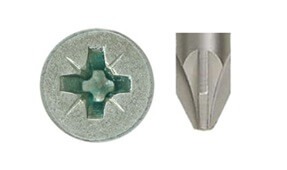 |
The best way to identify a Pozidriv head is by the diagonal engraved lines between the four points of the cross head.
You can use a Phillips screwdriver with a pozidriv screw but there is a high risk that it will cam out and slip under load, damaging the recess. Therefore it is always best to use a pozidriv screwdriver or bit. The best way to recognise a Posidriv head on a screwdriver or bit is by the parallel flanks either side of the four main points of the head.
Interesting fact – the word Pozidriv is almost always misspelt as either Posidrive or Pozidrive!
Phillips
Unlike Pozidriv recesses, Phillips heads are designed to slip if too much power is applied. This is to prevent the head of the screw from being twisted off if too much power is applied. Phillips recesses do not have the diagonal lines between the four points of the cross head.
| PHILLIPS HEAD |
 |
You cannot use a Pozidriv headed tool on a Phillips recess, it will only damage the screw and render it unusable.
Slotted
A traditional design still commonly used on machine screws but now less popular on woodscrews, the biggest benefit of a slotted drive lies in its simplicity – a slotted screw has a straight slot that has been machined across the whole diameter of the head. This means that in the absence of a screwdriver, a slotted screw can by turned with any manner of impromptu tools such as coin or a knife.
| SLOTTED HEAD |
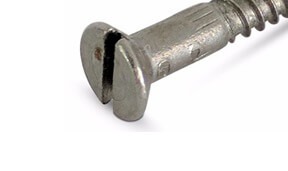 |
The downside to using this type of drive is that the screwdriver or bit has a tendency to slip out of either side of the slot.
Star or Torx Drive
Star or Torx drives feature a six-pointed star-shaped recess with rounded points on the star. Like the Posidriv, the main reason for the development of this drive was the ability to impart increased torque loads on the head without the fear of the tool slipping. Another beneficial feature of the torx drive is that less effort is required by the operator, as the transfer of torque is more efficient. Torx drive recesses are commonly used in the automotive industry for this reason.
| STAR / TORX HEAD |
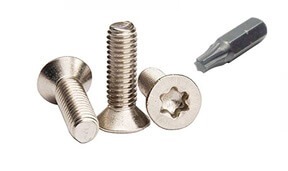 |
Security torx heads are very similar, with the additional feature of a small raised pin within the recess.
Hex Drive Recess
A six-sided hexagonal recess that can be driven by a hex key (often called an Allen key), a hex headed screwdriver or a hex bit.
| HEX DRIVE |
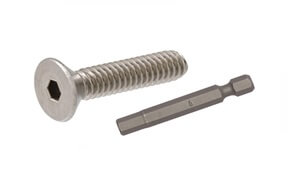 |
Square Drive Recess
Square recessed heads, sometimes called a Robertson head, are driven by a square headed driver or bit. With a deep recess and four solid points of contact, there is no chance of slippage, allowing high levels of torque to be transferred to the fixing.
| SQUARE DRIVE |
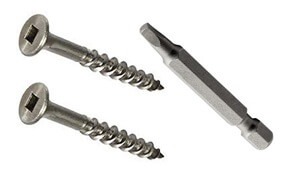 |
Provided that a correct sized good quality tool is used to make the drive there is no chance of stripping the recess with this design.
Often found on deck screws and self drilling screws.
Other common styles
Cross or Double Slot
Like a slotted recess but with two slots cut perpendicular to each other to form a basic cross shape. Cross recesses are commonly found on roofing bolts.

